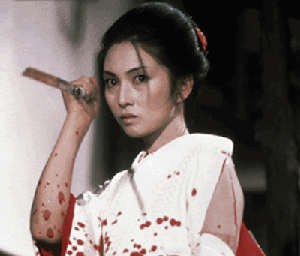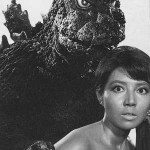It’s now well known that the seventies are still considered a great period of moviemaking. Many taboos were broken, especially regarding the more permissive treatment of sex and violence. And at last, female roles were becoming more rewarding in terms of screen action. We have already discussed the careers of Americans Pam Grier and Claudia Jennings, prime exemple of this then new trend. In this particular period in Japan, a small actress named Meiko Kaji began working in a couple of ground-breaking series that would create some new female movie icons still revered in these current years. Who could ever forget her deadly silhouette clad in a long raincoat?
Masako Ota was born in Tokyo on March 24, 1947. Nothing much is really known about her youth. She started her movie career in the mid-sixties, for the mighty Nikkatsu Studio, quickly costarring along the legendary Sonny Chiba. But these first projects stuck her in minor roles. The pivotal moment in her career took place in 1970. Changing her name to Meiko Kaji, she was elected to be the main star in a series called Alleycat (or Stray Cat) Rock, which mainly followed the doings of a gang of female delinquents. Meiko portrayed the leader of this gang, already creating the imperturbable screen persona that became her claim to fame, in Stray Cat Rock: Sex Hunter. The Alleycat Rock series was very popular among the disenchanted Japanese youth, mainly for its inventive visuals and girl fights, and Meiko followed soon after in another entry, Stray Cat Rock: Wild Measures ’71. Thus, she had been part in two of the episodes, which totalized five in all.
In 1970, Meiko took part in Blind Woman’s Curse, a quasi-horror movie, where our actress played a swordswoman not unlike the mythical hero Zatoichi. Around that time, Nikkatsu (the oldest Japanese movie studio, founded in 1912) began producing their line of soft-core motion pictures, which would make them extremely popular. With plenty of female nudity (but with no showing of genitals, as ordered by Japanese law) and occasional violence, these sometimes crude pictures are still why Nikkatsu is remembered today, mainly their bondage series. Meiko Kaji wanted no part of that, however, and she migrated to rival Toei Studio in 1972.
This was a wise move, as Meiko created the character that she will be best identified with: Nami Matsushima, aka Sasori, aka Matsu the Scorpion, for a new series derived from a manga about female convicts. The “Meiko stare” was thusly present in the first entry, Female Prisoner #701: Scorpion. Still cool as ice and mainly mute the whole time, our actress communicated her emotions mainly with her starring eyes, which could melt any hard-assed prison principal. Seemingly aloof, Sasori remains one of the ultimate action heroine in world cinema. The first episode also contains the only (brief) nude scene of Meiko. Unjustly imprisoned, tortured and humiliated, Sasori would not be reduced to a sorry state, like some mere whimpering lass: she would almost become a symbol of the emancipatory struggle of all women.
The second episode, Female Convict Scorpion Jailhouse 41, follows in the same vein, with a jailbreak and Sasori’s revenge on some brutal jail officials. An action movie with sometimes allegorical overtones (mainly in its presentation of the convicts’ memories), this is essential viewing. Once again, Meiko wearing a long raincoat and then-trendy large hat became an iconic image in film history, as like Tarzan’s loincloth or Charlie Chaplin’s funny hat.
1973 remains Meiko’s busiest year, participating in no less than three great Japanese films series. First, she was seen in the second episode of the legendary Yakuza Papers series, Deadly Fight in Hiroshima, which in Japan is the equivalent of the american Godfather saga. Then, she introduced a new character, Lady Snowblood, in the movie with the same title, again based on another manga. It’s now known that this project was the main inspiration for Quentin Tarantino’s two Kill Bill movies, as both would be important in a Meiko revival more than 25 years later. Lady Snowblood proposed a female assassin intent on avenging her mother for wrongdoings. Here, she’s an implacable instrument of vengeance, a delicate beauty that could shed copious amount of blood in only one swordstrike. Again, Meiko’s starring eyes are utilized in a most eerie fashion.
Then followed the third episode of Female Scorpion series, Female Prisoner Scorpion: Beast Stable, once again depicting some fascinating images. Oddly, Toei replaced the director, Shunya Ito, by Yasuharu Hasebe for the fourth episode, Female Convict Scorpion: Grudge Song. Disappointed by this, Meiko decided to leave the series, which will produce a fifth entry without her. It’s worth noting that Meiko had also a career as a singer, having first sung in one of her Alleycat movie. The theme songs of Lady Snowblood and Female Scorpion had her vocals on it. It’s still possible to get anthologies of her recording work.
The short Lady Snowblood series concluded with its second installment, Love Song of Vengeance, with a more political script. In 1975, Meiko participated in another high-profile project, Yakuza Graveyard, playing the sister of a gangster boss who falls in love with a cop. Oddly, after a trio of more minor films in 1978, Meiko Kaji almost completely disappeared from movie screens, with only an handful of titles here and there. It seemed that she turned down many roles again and again; already blasé at thirty years of age? Still, she continues to pop up on Japanese television.
With the releasing of the first couple of episodes of the Female Scorpion series and the Lady Snowblood ones, interest in Meiko Kaji grew. The release of the Kill Bill movies, which included each a song by Meiko on their soundtracks, were also factors in this interest. Whatever were her reasons to leave the movie business, she could be satisfied with creating an immortal and unique persona, a real movie legend, not a small feat for an diminutive actress from the Orient!
Filmography
1965 Kanashiki wakare no uta; Sasurai wa ore no unmei; Seishun zenki aoi kajitsu; Otoko no kunshô ryûten no okite; Aitsu to no bôken; Nakaseru ze; Akai tanima no ketto; 1966 Seishun a gogo; Nippon chimatsuri kenkajô; Taiyô ga daisuki; Yogiri no bojô; Aitakute aitakute; Namida kun sayonara; Anata no inochi; Yaru ka yarareru ka; Zesshô; Watashi wa nakanai; Arashi wo yobu otoko 1967 Gincho nagaremono: Mesuneko Bakuchi; Hoshi yo nagekuna shôri no otoko; Yogiri yo konya mo arigato; Hana wo kuu mushi; The Endless Duel 1968 Otoko no okite; Daikanbu burai; Aru shôjo no kokuhaku kindan no kajitsu; Aa himeyuri no tô; Nawabari wa moratta; BG aru 19 sai no nikki agete yokatta! 1969 Yoru no mesu hana to chô; Onna no Keisatsu; Koi no tumuji kaze; Hana no mesu toshi ue no onna; Yabanjin no nekutai; Zankoku onna shikei; Nippon zangyôden; Sakura sakazuki jingi; 100 Gamblers; Kyôka restuden shûmei tobaku; Gokudô petenshi; Akasaya jingi tekka midare zakura; Arashi no yûsha tachi 1970 Onna banchou: Nora-neko rokku; Alleycat rock: Wild Jumbo; Stray Cat Rock: Sex Hunter; Kaidan nobori ryu; Tekkaba bojyo; Kantô girikyôdai; Sakariba jingi; Hikô shônen wakamono no toride; Nippon saidai no kaoyaku; Hana no tokkôtai aa senyû yo; Hangyaku no melody; Step on the Gas; Noraneko rokku: machin animal 1971 Stray Cat Rock: Wild Measures ’71; Ryuketsu no koso; Yoru no saizensen: tôkyô maruhi chitai; Sannin no onna: yoru no chô; Bôryokudan: norikomi; Asagiri; Onna no iji 1972 Female Prisoner #701: Scorpion; Female Convict Scorpion Jailhouse 41; Kinchô wataridori; Ginchô nagaremono; 1973 Female Prisoner Scorpion: Beast Stable; Female Prisoner Scorpion: #701’s Grudge Song; Lady Snowblood; Deadly Fight in Hiroshima; Gendai ninkyôshi 1974 Lady Snowblood 2: Love Song of Vengeance; Jeans blues asunaki buraiha; Mujuku 1975 Shin jingi naki tatakai: kumichô no kubi; Dômyaku rettô; Takehisa yumeji monogatari: koisuru 1976 Between Women and Wives; Lullaby of the Earth; Yakuza Burial: Jasmine Flower 1977 Sabita honô 1978 Double Suicide of Sonezaki; 1980 Bad Sorts 1981 Kodomo no koro sensô ga atta 1986 Tree Without Leaves 1988 Aoi sanmyaku 88 1995 Onihei hankachô; Hanayome wa 16-sai 1999 Zeno kagiri naki ai ni
Check out these other Siren profiles:
Submit your review | |










